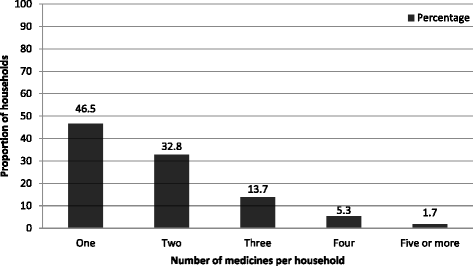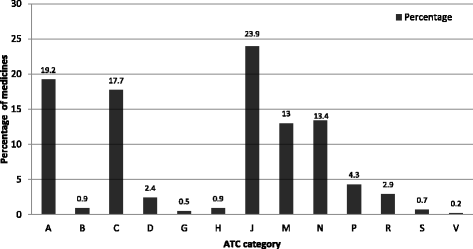A household survey of medicine storage practices in Gondar town, northwestern Ethiopia
- PMID: 28274219
- PMCID: PMC5343301
- DOI: 10.1186/s12889-017-4152-8
A household survey of medicine storage practices in Gondar town, northwestern Ethiopia
Abstract
Background: Household surveys are crucial to get accurate information on how medicines are acquired, and used by consumers, as they provide the best evidence in the area. The objective of this study was to document household medicine storage practices in Gondar town, northwestern Ethiopia.
Methods: A cross-sectional household survey was conducted from April 5 to May 6, 2015. In the study, 809 households were surveyed from four sub-cities in the town selected through multistage sampling with 771 included in the final analysis. Data on the extent of storage, storage conditions, sources of medicines and their current status among others were collected through structured interviews and observations. The data were entered in to Epidata version 3.1, exported to and analyzed using Statistical Packages for Social Sciences (SPSS) version 21.
Results: Of the 771 households in the study, 44.2% stored medicines. Presence of family members with chronic illness(es) and higher levels of household incomes predicted higher likelihood of medicine storage. In the households which allowed observation of stored medicines (n = 299), a mean of 1.85 [SD = 1.09] medicines per household were found. By category, anti-infectives for systemic use (23.9%), medicines for alimentary tract and metabolism (19.2%) and those for cardiovascular system (17.7%) ranked top. Among individual medicines stored, diclofenac (10.7%), paracetamol (9.9%) and amoxicillin (8.0%) were on top of the list. Dispensaries (97.8%) and physicians (83.5%) were almost exclusive sources of medicines and advices/orders for medicines respectively. Nearly two-thirds of the medicines found were on use and a vast majority (76.5%) were stored in chests of drawers. Proportion of expired medicines was very low (3.14%).
Conclusions: The use of physicians' and pharmacists' advice to get medicines; use of dispensaries as principal sources, large proportion of medicines being in use and very low proportion of expiry showed good practices. However, storage places of medicines were not purpose built. Encouraging good practices through continued medicine use education and advocating appropriate medicine storage in medicine cabinets is required to improve storage conditions and consequent use of medicines.
Figures


Similar articles
-
Medicine storage, wastage, and associated determinants among urban households: a systematic review and meta-analysis of household surveys.BMC Public Health. 2021 Jun 12;21(1):1127. doi: 10.1186/s12889-021-11100-4. BMC Public Health. 2021. PMID: 34118923 Free PMC article.
-
Household storage and disposal of unused and expired medicines in Dessie, Ethiopia: a cross-sectional study.Front Public Health. 2024 Oct 24;12:1422304. doi: 10.3389/fpubh.2024.1422304. eCollection 2024. Front Public Health. 2024. PMID: 39512718 Free PMC article.
-
Pattern and predictors of medicine use among households in Gondar Town, northwestern Ethiopia: a community-based medicine utilization study.BMC Res Notes. 2017 Jul 28;10(1):357. doi: 10.1186/s13104-017-2669-7. BMC Res Notes. 2017. PMID: 28754170 Free PMC article.
-
Household Storage of Medicines and Associated Factors in Tigray Region, Northern Ethiopia.PLoS One. 2015 Aug 14;10(8):e0135650. doi: 10.1371/journal.pone.0135650. eCollection 2015. PLoS One. 2015. PMID: 26275057 Free PMC article.
-
Storage and disposal of pharmaceuticals at home: a systematic review.Cien Saude Colet. 2020 Feb;25(2):585-594. doi: 10.1590/1413-81232020252.10882018. Epub 2018 Jun 20. Cien Saude Colet. 2020. PMID: 32022198 English, Portuguese.
Cited by
-
Assessment of Knowledge, Attitude, and Disposal Practice of Unused and Expired Pharmaceuticals in Community of Adigrat City, Northern Ethiopia.J Environ Public Health. 2020 Apr 14;2020:6725423. doi: 10.1155/2020/6725423. eCollection 2020. J Environ Public Health. 2020. PMID: 32351582 Free PMC article.
-
The magnitude and associated factors of unused medications storage practice among households in Jimma city, southwest of Ethiopia: Community-based cross-sectional study.Explor Res Clin Soc Pharm. 2024 Jun 8;15:100459. doi: 10.1016/j.rcsop.2024.100459. eCollection 2024 Sep. Explor Res Clin Soc Pharm. 2024. PMID: 38983638 Free PMC article.
-
Medicine storage, wastage, and associated determinants among urban households: a systematic review and meta-analysis of household surveys.BMC Public Health. 2021 Jun 12;21(1):1127. doi: 10.1186/s12889-021-11100-4. BMC Public Health. 2021. PMID: 34118923 Free PMC article.
-
Disposal practices of unwanted household medications in China: a cross-sectional study.BMJ Open. 2025 May 14;15(5):e088086. doi: 10.1136/bmjopen-2024-088086. BMJ Open. 2025. PMID: 40374227 Free PMC article.
-
Attitudes and Practice Regarding Disposal for Unwanted Medications among Young Adults and Elderly People in China from an Ecopharmacovigilance Perspective.Int J Environ Res Public Health. 2019 Apr 25;16(8):1463. doi: 10.3390/ijerph16081463. Int J Environ Res Public Health. 2019. PMID: 31027160 Free PMC article.
References
-
- World Health Organization (WHO) International Working Group for Drug Statistics Methodology, WHO Collaborating Centre for Drug Statistics Methodology, WHO Collaborating Centre for Drug Utilization Research and Clinical Pharmacological Services. Introduction to drug utilization research. World Health Organization 2003.
-
- Hardon A, Hodgkin C, Fresle D. How to investigate the use of medicines by consumers. World Health Organization/University of Amsterdam/Royal Topical Institute. Geneva: World Health Organization; 2004.
-
- de Joncheere K, Rietveld AH, Huttin C. Experiences with generics. International Journal of Risk & Safety in Medicine Prices, affordability and cost containment. In: Dukes MNG, Haaijer-Ruskamp FM, de Joncheere CP, Rietveld AH, editors. Drugs and money. 2. Amsterdam: Ios Press; 2003.
-
- World Health Organization. Manual for the Household Survey to Measure Access and Use of Medicines. World Health Organization 2008. Geneva. Available: http://www.who.int/medicines/areas/coordination/household_manual_februar.... Accessed 23 Dec 2014.
-
- Arhinful DK. WHO level II household survey to measure access to and use of medicines in Ghana. WHO medicines survey conducted in Ghana in May/June 2008. Ministry of Health, Ghana. 2011. Available: http://apps.who.int/medicinedocs/documents/s17742en/s17742en.pdf. Accessed 04 March 2017.
MeSH terms
LinkOut - more resources
Full Text Sources
Other Literature Sources
Miscellaneous

